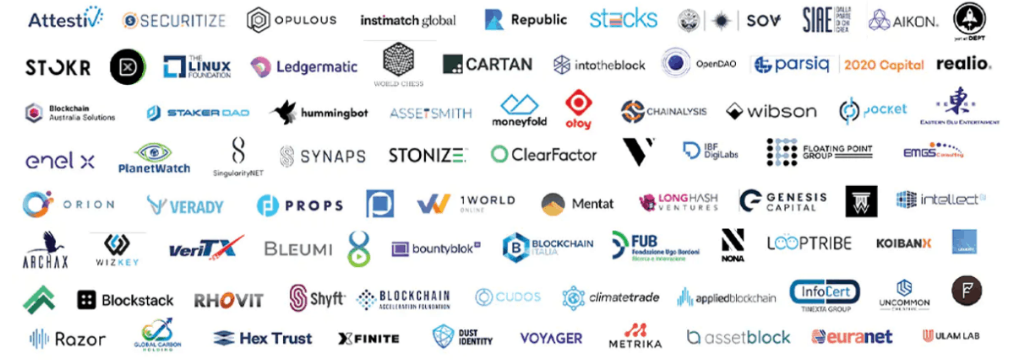Algorand review – Algorand is one of the strongest projects in the crypto space and we’re going to take a good look at why
Algorand Review
Algorand (ALGO) is a high-level blockchain project, designed by cryptographer Silvio Micali, focused on high-speed transaction processing and high-level smart contracts for decentralized finance ( Defi ).
The goal of this network is very clear: to be a network designed and built to be scalable, inexpensive, extensible, and highly programmable. And, currently, this network is one of the third-generation blockchain projects that has grown the most in recent years.

But What exactly is Algorand? Does it really deliver on promises?
Origin of Algorand
Algorand’s story begins in 2017 when the company was created by Silvio Micali, a well-known MIT professor, Turing Award winner, and cryptography specialist. Micali, who has been part of the crypto community since 1980, has done significant work in asymmetric cryptography and is the co-creator with Shafirira Goldwasser of the zero-knowledge test (ZKP).
Micali, who has always been a researcher, is an expert in blockchain and Bitcoin (BTC) technology by 2015. At that point, Micali began working on his personal cryptocurrency project, determined to improve its Bitcoin specifications and the already well-known Ethereum. This led him to associate with Nickolai Zeldavich, a colleague of MIT who served as the Head of Distributed Systems at this institution, and who participated in the Computer Science and Artificial Intelligence Laboratory (CSAIL).

Nickolai’s first impression led to a large-scale experiment to test Micali’s initial proposal. The test was carried out using Amazon servers and forcing the system with up to 500,000 concurrent users on the network. The tests were successful for being an unpolished version of the system and this led them to the next stage: the creation of Algorand. In principle, a total of 11 people participated in the team, who met at Micali’s home to do their work.
Nickolai decided to conduct a large-scale experiment to test Micali’s initial proposal. The test was carried out using Amazon servers and pushing the system with up to 500,000 concurrent users on the network. The results were successful for an unpolished version of the system and this led them to the next stage: the creation of Algorand.
Algorand Review – the first success
The work first paid off when a $ 4 million seed capital was reached with investors Pillar and Union Square Ventures in February 2018. Subsequently, another $ 62 million funding round would come in October 2018. , from the hand of other investors. In the same month, Algorand named Steve Kokinos as CEO, and Sean Ford (former CMO of LogMeIn) as COO. The message was clear: we are going to grow our business.

The work was made public in May 2019, with the arrival of the Testnet network. But along with his presentation, parallel work was initiated to ensure a university participation program in the project. Thus born in June 2019 the Global University Program, in which the best universities in the United States, Canada, Europe, the Middle East, and China were invited to be part of the inaugural university research program.
Founding members include Massachusetts Institute of Technology, Peking University, Sapienza University of Rome, Stony Brook University, Tel Aviv University, Tsinghua University, University of California, University of Berkeley, University of the Italian Switzerland, and, University of Waterloo.
In addition to this, the first ALGO token auction was held, and a week later the main exchanges of the crypto community would add the token. Thus begins the long journey of Algorand as a new cryptocurrency and blockchain development platform.
Algorand’s goal
Algorand’s main goal is to become a platform dedicated to offering decentralized applications (DApps) and high-speed Defi that are within everyone’s reach. To achieve this, Algorand is a “permissionless” blockchain. In this way, anyone can be part of it, within a transparent system where everyone can achieve success through decentralized projects and applications.
On the other hand, to address the Blockchain Trilemma, Algorand is based on a powerful and fast consensus protocol that can be used by any user with minimal computing power, who owns $ ALGO and is online. All these elements give you the right to be chosen to participate in the Algorand block consensus, which is a derivative of the Proof of Participation.
But along with this, Algorand focuses its development on creating tools that facilitate the implementation of decentralized applications and all the infrastructure necessary for their operation.
How does Algorand work?
As we discussed earlier, Algorand is a blockchain and an authorization-less network. This first point is fundamental to eliminating any type of barrier in the use and evolution of the protocol. The main idea behind this principle is to ensure a high level of decentralization, scalability, and security.
Secondly, the functioning of Algorand is based on a consensus protocol derived from Proof of Stake (called Pure Proof of Stake- PPoS). This system was created to guarantee the full participation of those who are part of the network, guaranteeing protection and speed. The use of PPoS is part of the achievement of the block production speed measured in a few seconds, which would allow high scalability of the network, thus serving thousands of users at the same time, with very short waiting times and, above all, with very low commissions and costs.
In addition, the Algorand development team devised new consensus algorithms, fault-tolerant Byzantine systems, and a completely new hashing and digital signature system, focused on enabling the greatest possible scalability.
Pure Proof of Stake, Algorand’s pillar of high speed
The main pillar of Algorand’s scalability and speed is its Pure Proof of Stake (PPoS) protocol. This protocol is a derivative of the well-known Proof of Stake (PoS) of other cryptocurrencies such as Ethereum 2.0. The idea of this protocol in Algorand is to allow for sufficiently secure Byzantine failure resistance while providing great speed in generating and validating blocks within the network. At the same time, PPoS is able to support a large number of users at the same time and scale correctly as the network increases the number of validators.
The result? Algorand is able to manage about 2 thousand transactions per second without problems in the current state of the network. In fact, Algorand’s highest usage peak occurred on March 04, 2021, when that day alone it was able to handle more than 39 million transactions (around 451 TPS on average, peaking at 1153 TPS). To this, we can add a block generation time of 4 seconds on average, which leaves us one of the fastest blockchains you can count on today.
Algorand review – Vault, a new form of blockchain accounting
Other important innovations in Algorand are related to the way in which its ALGO token is generated and managed on the blockchain, both at the account and token generation level and cryptographically.
Let us remember that in blockchain it is necessary to know how a currency is generated to know its origin, and at that point, to know what its path is during its entire period of use. With Bitcoin, this is possible thanks to coinbase (which generates bitcoins) and UTXO (They tell us where the coins come from and where they go). However, Algorand uses none of this. Instead, Algorand created Vault, a completely different bootstrap or initial coin-making system.
Vault is a system that allows you to unlink the monitoring of account balances and transactions. Therefore, Vault only creates a recent history of operations, where older operations have no relevance.
On the other hand, Vault also allows you to use sharding for;
- Fragmentation of the account state between nodes, so that each node does not have to store the state of all accounts.
- Allow all transactions to be validated by all nodes, using a Merkle tree file to store balance information for each account.
- It adaptively caches the upper layers of the Merkle tree file so the bandwidth cost of transferring evidence from Merkle grows logarithmically with the number of accounts.
This ingenious system prevents an account from being created coins out of thin air, helps create a layer of defense against double-spending, simplifies accounting for coins within the network, and ultimately makes the Algorand blockchain more space efficient. compared to other options like Bitcoin or Ethereum.
Added to this is a cryptographic certificate system that seeks to reduce the cost to convince new users of the validity of a lock. To avoid fraud, this certificate system is verifiable at the network level, which prevents third parties from injecting invalid certificates into the network, which could create non-existent balances in new accounts (generate coins from scratch).
As a result, an Algorand blockchain with 500 million transactions would only take up about 500MB of hard drive space. The same Bitcoin equivalent, on the other hand, would occupy a total of 5 GB. This is a 90% reduction in the size of the blockchain, without decreasing, while defending, security.
Algorand review the main features
The main feature of this project is the open-source public blockchain. Algorand’s consensus mechanism promotes the performance, security, and openness of a decentralized network. That said, Algorand’s transaction performance is bound to compete with popular financial and payment systems.
According to the development team, these are the key properties of the Algorand protocol:
- Low compute requirements: no need for mining farms which consume a lot of energy.
- Quick Deal: The entire community accepts the next block and confirms transactions with latency in about a minute, scaling to many users.
- Delegation: Token holders can delegate their tokens if they want to participate in the consensus.
- Extremely low probability of fork – users can trust a new block as soon as it appears. Even if the network is temporarily partitioned, Algorand guarantees that no user has diverging opinions on the confirmed transaction.
- True decentralization: the network is not controlled by a few miners or a group of validators, as proponents and committees are randomly selected.
- Governance: community token holders can propose changes to protocols and agree on their ability to evolve.
- Using scientific research and influential business partners: Algorand collaborates with trusted business leaders who work in world-renowned companies.
- Total Token Distribution: 10,000 billion ALGO tokens.
- Estimated circulating supply of ALGO tokens to be placed on the market (initially through auctions) during the first 5 years (600 million c / year), for a total of 3,000 million.
- The estimated reward for participation (spread over time): 1.750 billion ALGO tokens.
- Relay nodes or relay brokers: 2,500 million ALGO tokens.
- Algorand & Algorand Foundation, Inc. (distributed over time) 2,500 billion ALGO tokens.
- End User Grants (distributed over time): 250 million ALGO tokens.
In addition, other functions that can be exploited in Algorand with its smart contracts are:
- Creation of escrow accounts ( Escrow payments )
- Loan payments and commission foreclosures
- Limited orders
- Suscripciones
- Covered bonds
- Regulated and automated payments
- Scheduled recurring fees / recurring debt
- High-security account delegated management
- Interface with off-chain data providers
- Atomic transfers between chains
- HELOC (Home Equity Line of Credit)
- Decentralized Exchanges (DEX)
- Validation of the refund
- Cross-chain atomic swaps.
This is the future of Algorand, the one that is under construction and that is supported by various companies, universities, and communities that have different roles in the world of cryptocurrencies.

Algorand Review – Conclusion
Algorand is one of the strongest projects in the crypto space, one of the titans, but it has its flaws which I discuss in detail on our Quora Space: The Crypto Boss.





